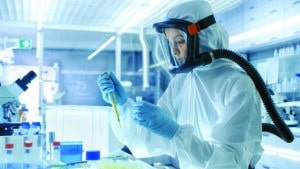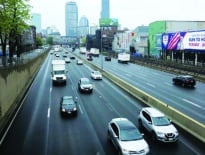As the biotech building boom brings groundbreakings for dozens of new lab buildings to Boston and Somerville, officials are taking a fresh look at how to safeguard public health without driving away a growing source of jobs and tax revenues.
Newly-elected Somerville Mayor Katjana Ballantyne will submit a new biosafety ordinance to the City Council this winter, city spokeswoman Denise Taylor said, in the first update to Somerville’s code in over two decades. The city is reviewing a series of major lab projects in Union Square, Boynton Yards, the Inner Belt and Assembly Square.
The Boston Planning & Development Agency is studying changes to its own lab project reviews, reflecting the unique design of research buildings with their sprawling floor plates, powerful ventilation systems and massive mechanical equipment. Another persistent question arising at community meetings: Which federally-defined biosafety levels will be permitted at a property, such as those that involve airborne infectious agents?
“I can’t think of a public meeting where there hasn’t been a question about, ’What biosafety levels are going to be in here?’” said Jennifer Schultz, a partner at Sullivan & Worcester LLP who represents developers seeking approval for 12 million square feet of lab projects in Boston, Quincy and Somerville.
In the COVID era, the availability of biosafety level 3 facilities has played a major role in vaccine development.
“What happens often is certain life science companies want the ability to pivot in their space from [biosafety level 2] to [biosafety level 3] quickly if the need arises.” Schultz said. “If every community said no to [biosafety level 3] and that had been the case one or two years ago, there’s no way we would have had [COVID] vaccines in six months.”
But some officials and residents bristle at plans for riskier research facilities and the potential for a genetically-engineered virus to escape containment and lead to a wider outbreak. At least six researchers at University of North Carolina-Chapel Hill were potentially exposed to lab-created coronaviruses in the five years before the COVID-19 outbreak, according to a 2020 investigation by the nonprofit newsroom ProPublica.
In August, President Joe Biden ordered U.S. intelligence agencies to investigate the origins of the COVID-19 virus while criticizing Chinese officials’ reluctance to share information about its outbreak in Wuhan, where a lab institute researches coronaviruses.
Questions about Lab Locations
Approximately 3 million square feet of office-to-lab conversions are proposed or under way in the city of Boston, according to a recent report by Colliers International. And millions of square feet of new ground-up lab construction are under way in the Seaport District, South End, Charlestown, Dorchester, the Fenway and Allston-Brighton.
Boston city councilors have objected to the arrival of lab buildings close to residential neighborhoods, primarily because of their height and noisy mechanical systems. Mayor Michelle Wu has voiced her support for life science projects in downtown Boston, citing the industry’s potential to fill vacancies in COVID-emptied office buildings and revive foot traffic.
Last year, the BPDA began an internal review of how lab projects are permitted in Boston. The city’s lab development pipeline was just starting to percolate prior to the onset of COVID-19 and has accelerated since early 2020, as venture capitalists pour billions into Bay State biotech companies.
While often considered a monolithic new development category, lab buildings comprise a wide array of building types and definitions. Following interviews with architects and developers, the BPDA is drafting design guidelines for the next wave of projects.
“We are still in the process of figuring out where labs are absolutely not appropriate and where they are appropriate,” BPDA Director of Planning Lauren Shurtlett said.
The BPDA will work with lab developers to design projects that fit into the goals of existing neighborhood planning studies such as the Plan: Dot Ave. initiative, Shurtlett added.
Brookline officials are reviewing new zoning to allow life science buildings for the first time, seeking to encourage redevelopment of a handful of commercial properties along Boylston Street. An advisory committee recommended against allowing biosafety level 3 or biosafety level 4 facilities at the advice of Dr. Swannie Jett, the town’s director of public health.
In Woburn, a zoning ordinance dating back to 2009 bans biosafety level 3 and biosafety level 4 facilities, Planning Director Tina Cassidy said.
Somerville’s existing biosafety ordinance is over 25 years old, and does not permit biosafety level 4 activity. The city approved its first major lab project in recent years at 101 South St. in Boynton Yards. Developers Leggat McCall Properties and DLJ Real Estate Partners now are proposing an additional 1.1 million-square-foot life science campus next door, and lab projects are being pitched in the McGrath Highway and Inner Belt areas.
The city’s recent lab boom has prompted a committee to take a second look. Somerville officials declined to discuss specifics of the new regulations pending the final version, expected to be submitted to the City Council within weeks.
A Tiered Assessment of Risks
The Centers for Disease Control and Prevention regulate life science research through a four-tier rating system that sets standards for employees’ use of protective equipment and design of laboratories. biosafety level 1 and biosafety level 2 apply to facilities that include research with low risk to humans, while biosafety level 3 allows research of serious diseases that can be transmitted through inhalation.
Boston city councilors rejected a ban on the biosafety level 4 level facilities – which research the most dangerous infectious diseases and are built with extensive containment and disinfection equipment – in 2014. That enabled Boston University to move forward with its infectious disease laboratory which began operating in 2018 on Albany Street in South End. The facility remains the city’s only biosafety level 4 facility.

Steve Adams
Although Boston does not yet regulate biosafety levels through zoning, developers now are expected to divulge their plans, and return to the agency if they seek a change in biosafety level use. In submitting a proposal for a 265,000-square-foot office-lab building in South End, The Druker Co. last week stated that the building “is anticipated to be tenanted” by biosafety level 1 and biosafety level 2 uses and that no biosafety level 3 or biosafety level 4 uses are contemplated.
Only seven locations in Boston currently permit biosafety level 3 activities, including Boston Children’s Hospital, Tufts Medical Campus, Dana Farber Cancer Institute and two Boston University facilities. Lab buildings also require reviews from other city agencies, ranging from the public health commission to Boston fire department, along with state and federal agencies.
Most commercial developers continue to focus on buildings designed for biosafety level 1 and biosafety level 2 uses, which comprise the bulk of tenant demand, said Dan McGrath, director of asset manager for Boston-based Berkeley Investments.
“The real estate brokers and architects and scientists said the vast majority of tenants you would be targeting would only be requiring biosafety level 2,” McGrath said.




 |
| 


